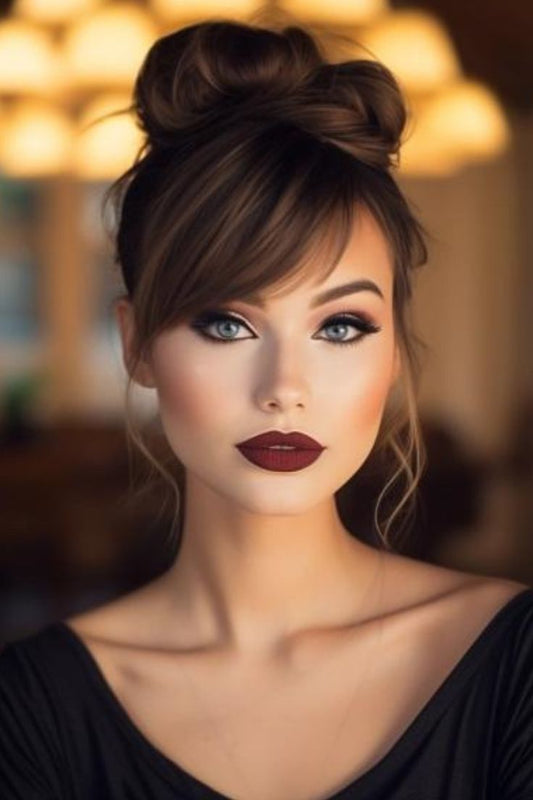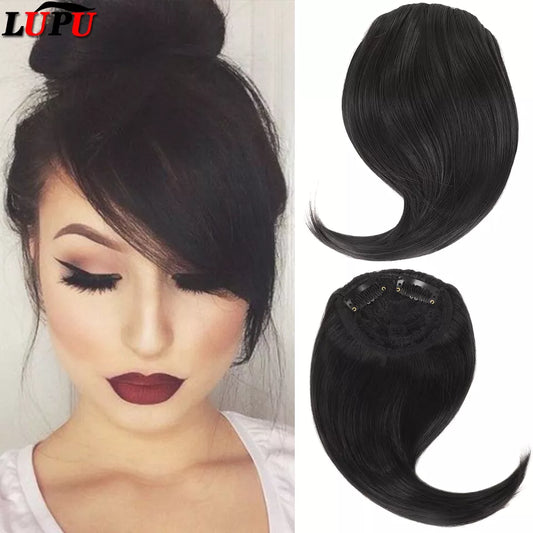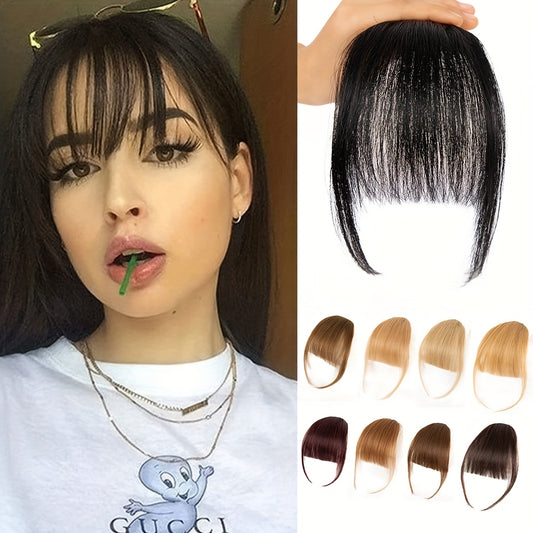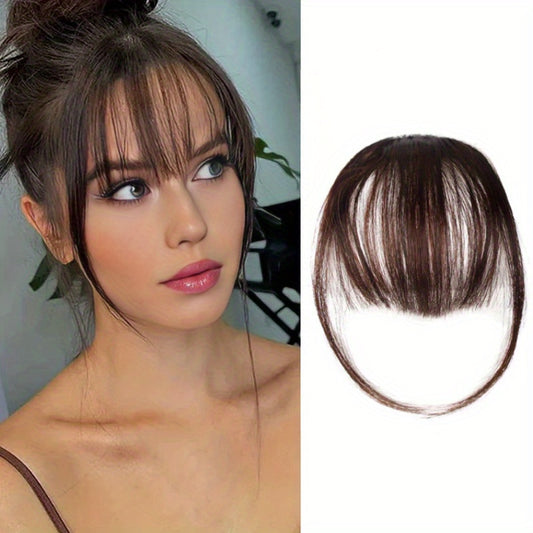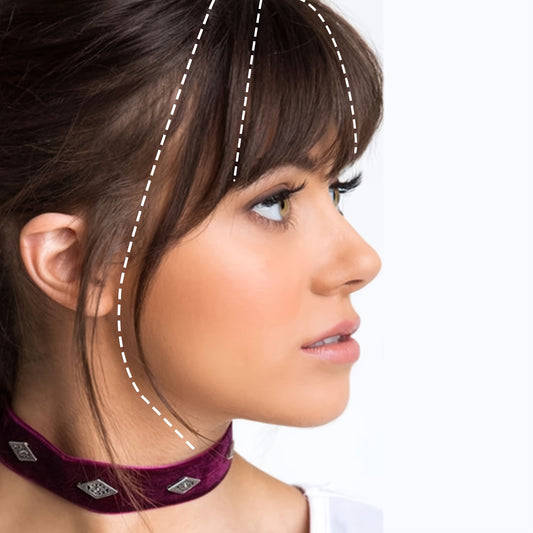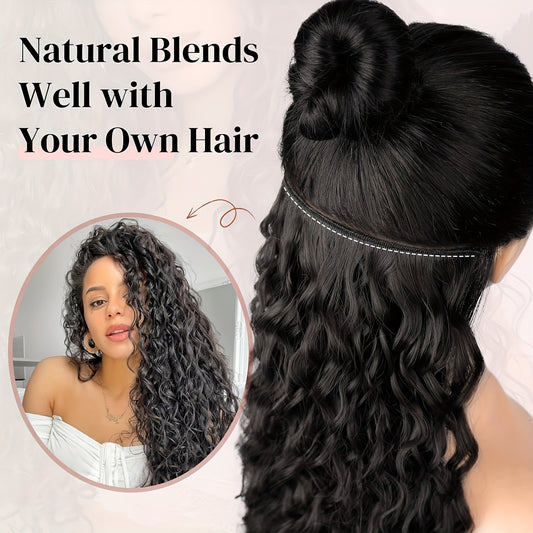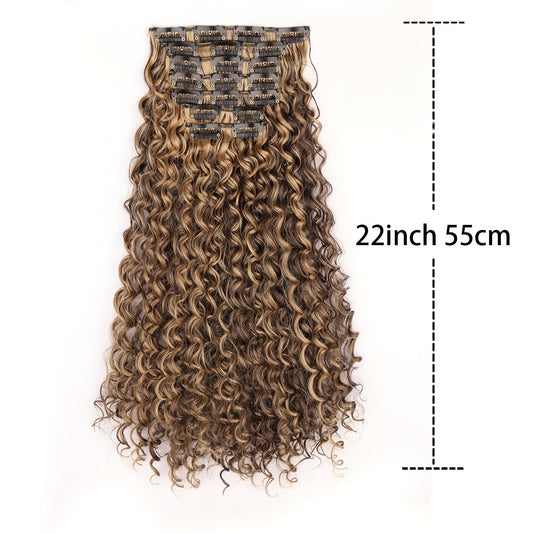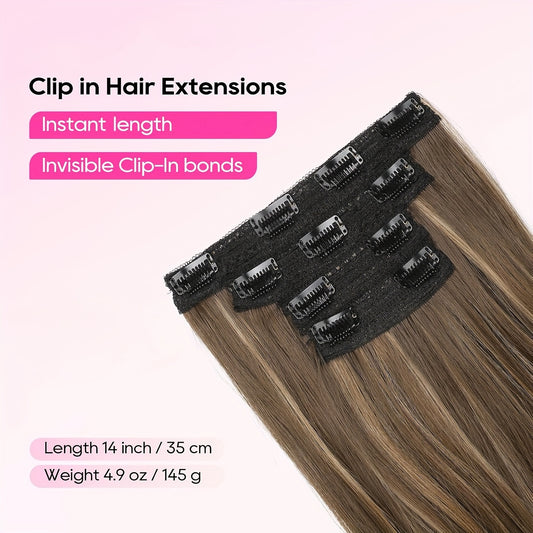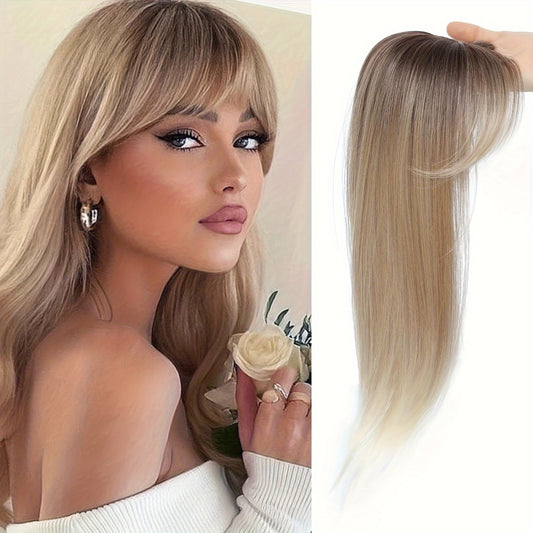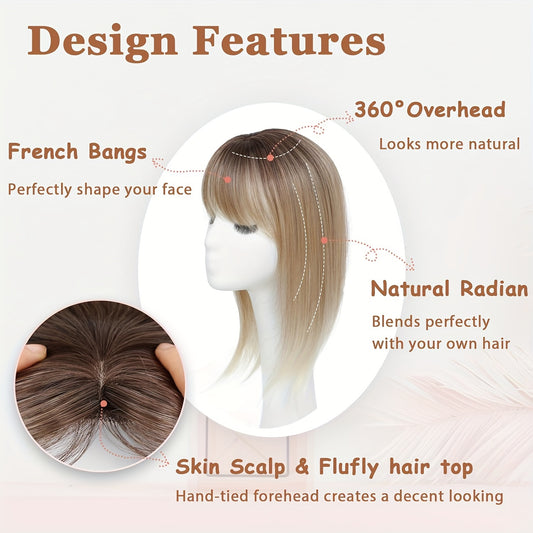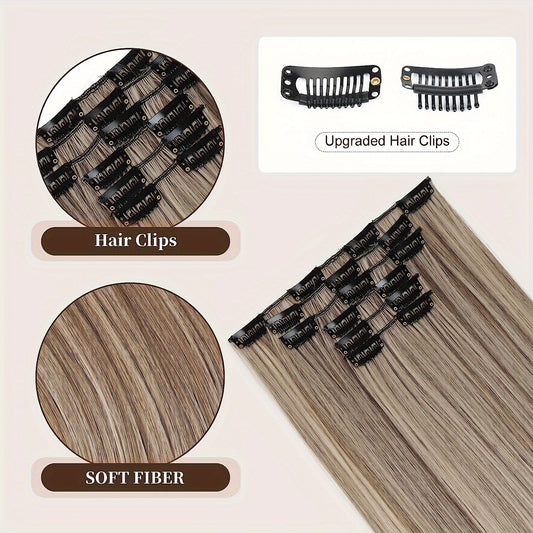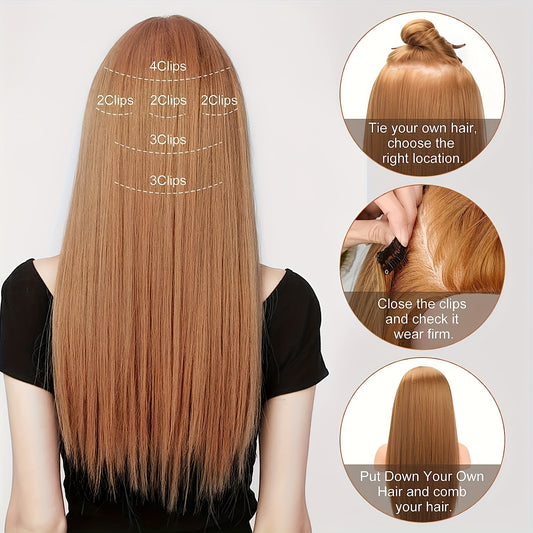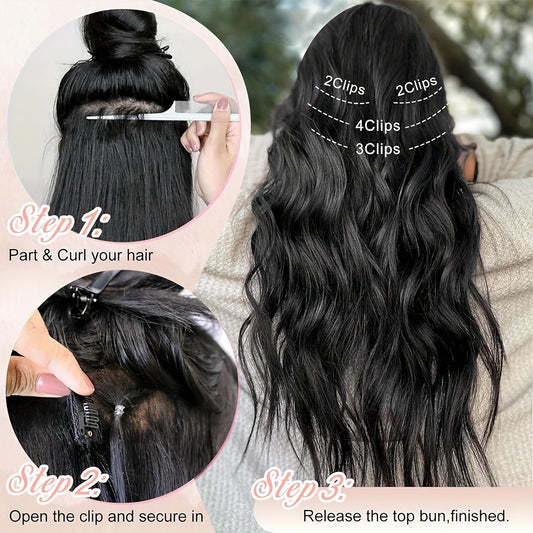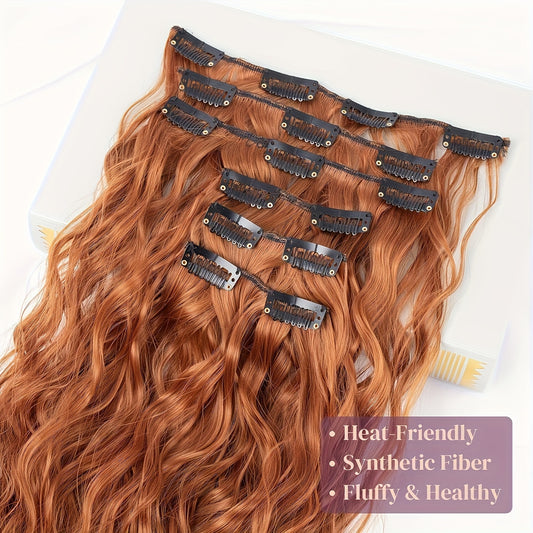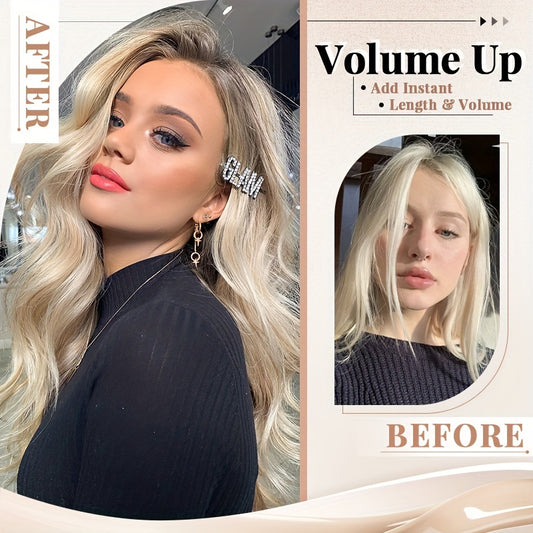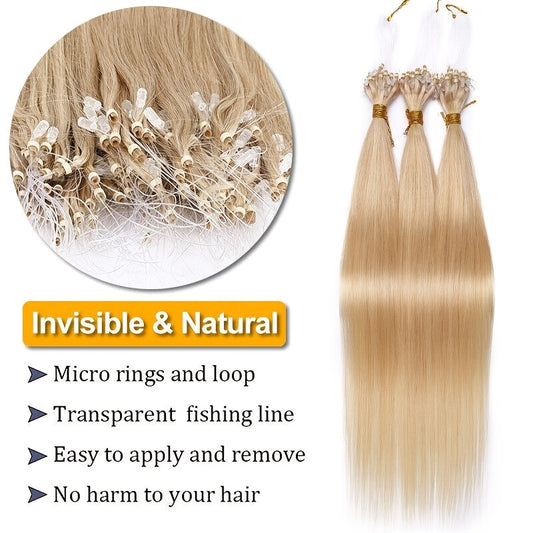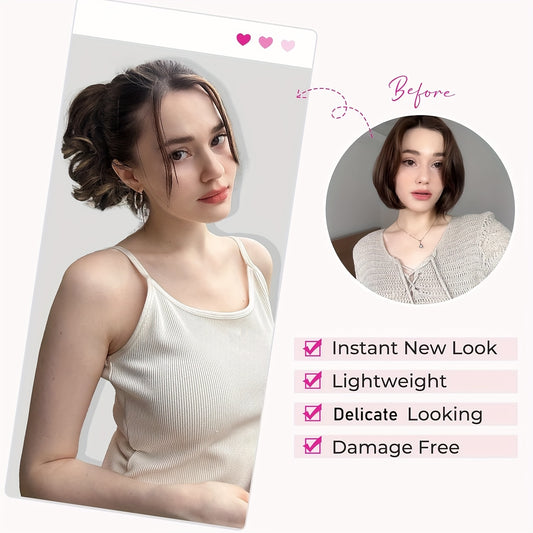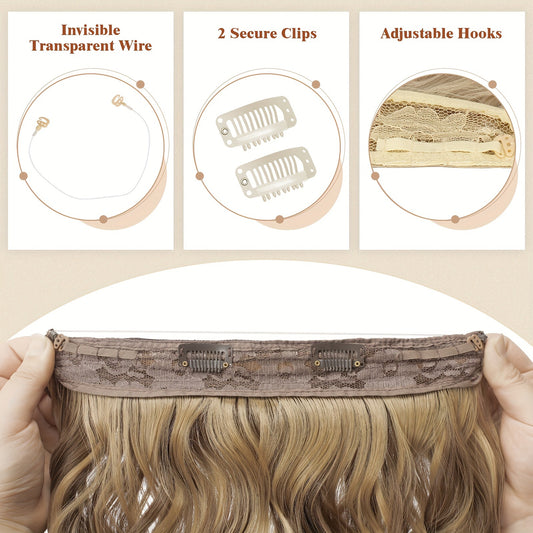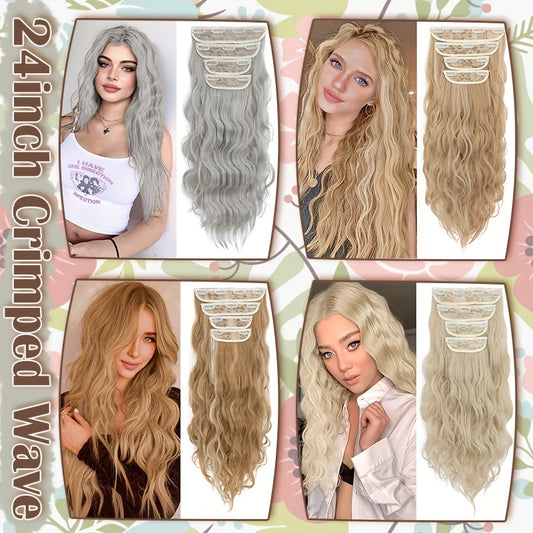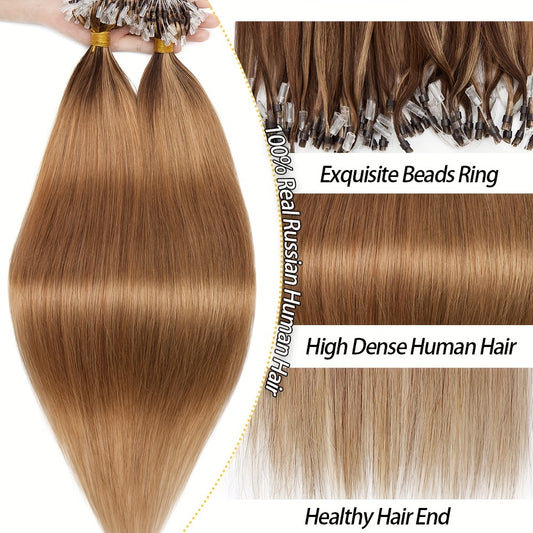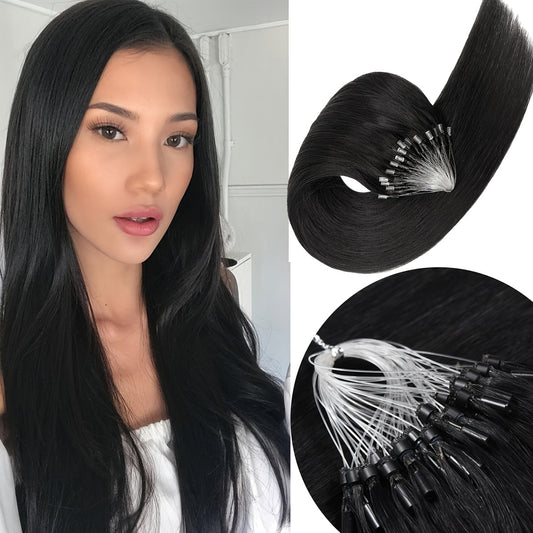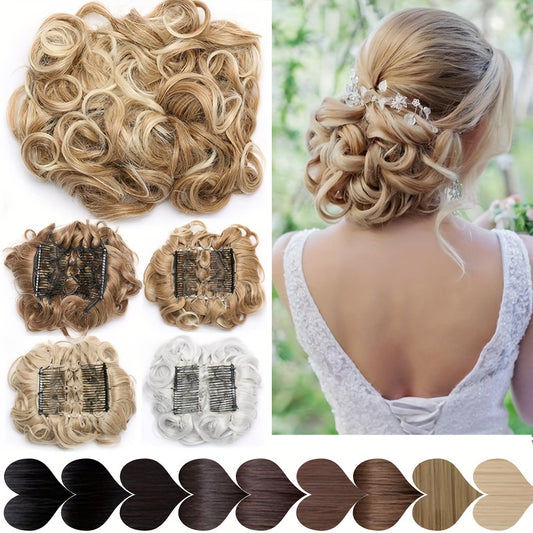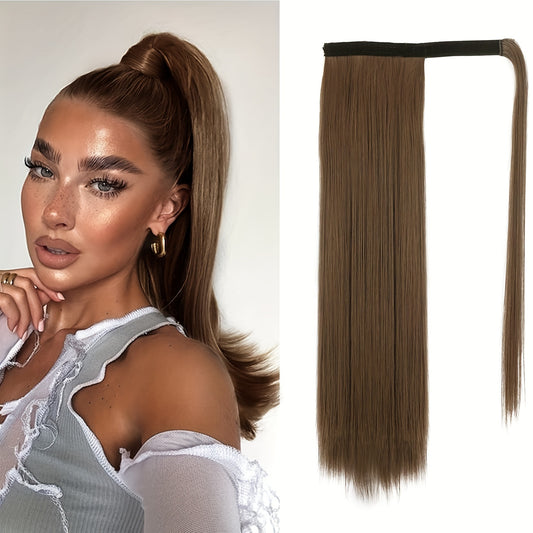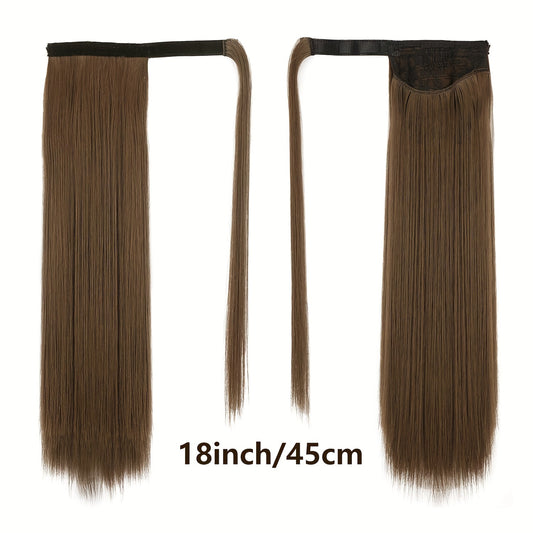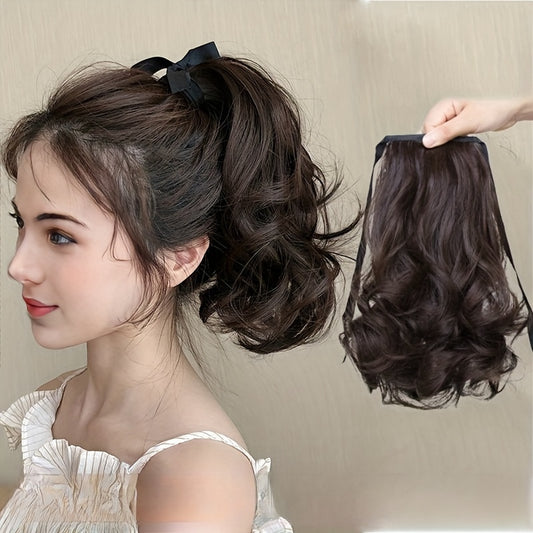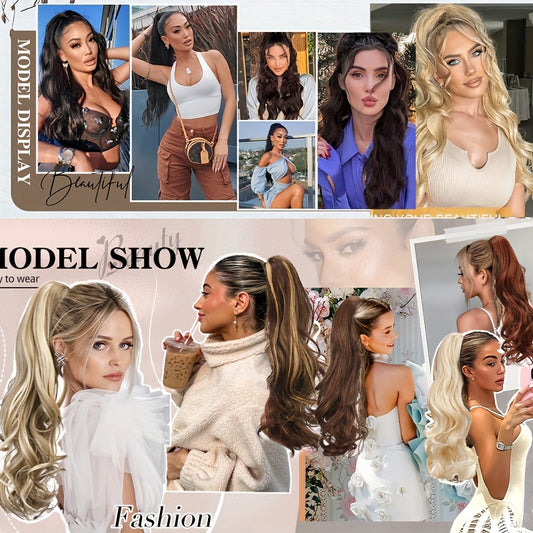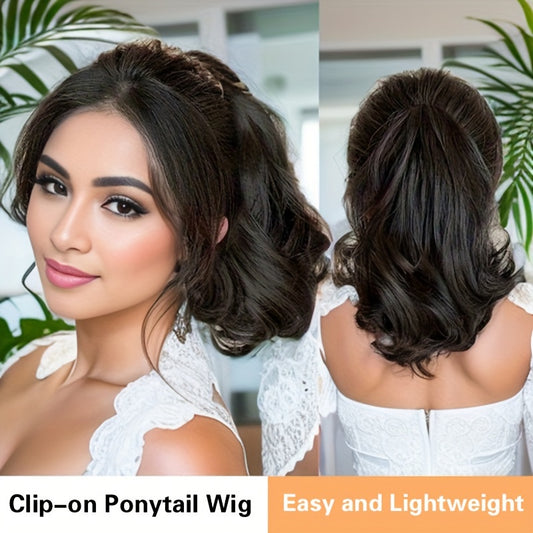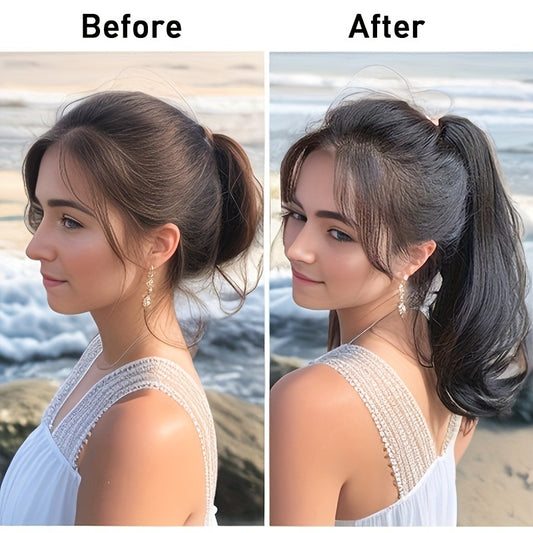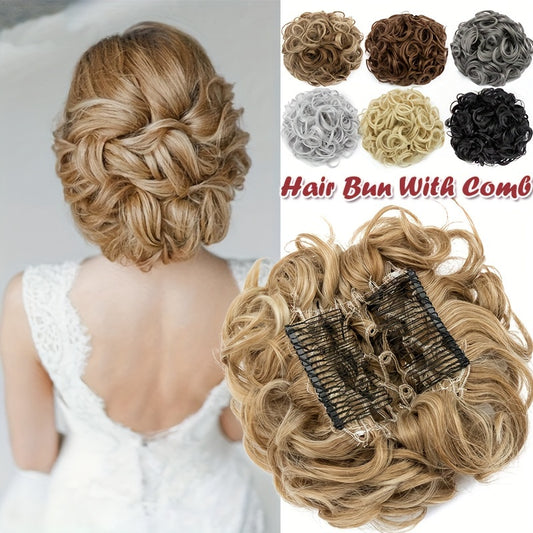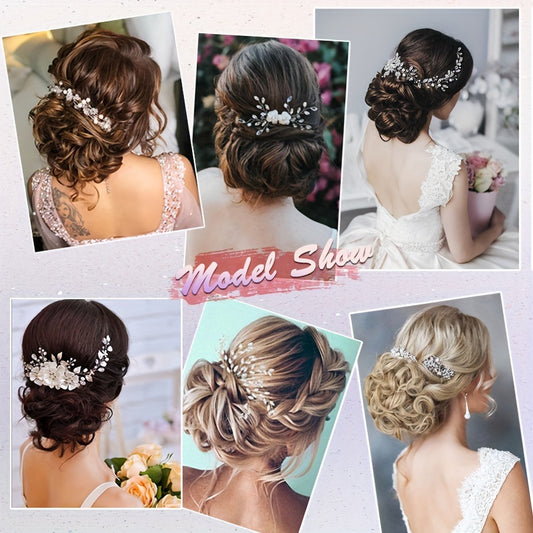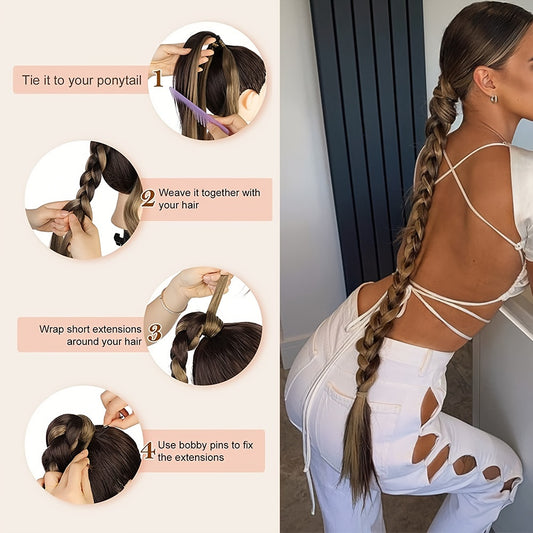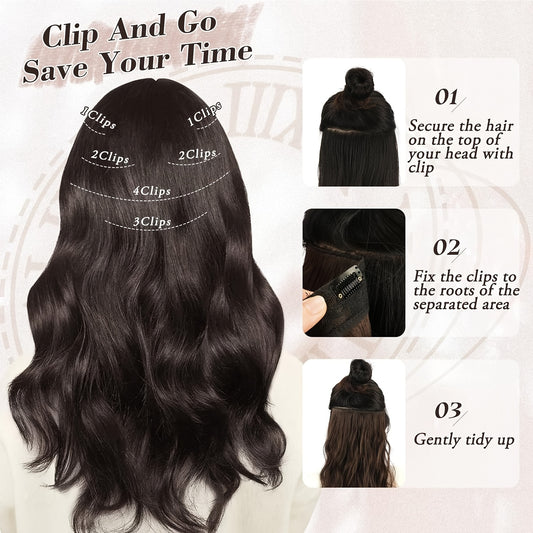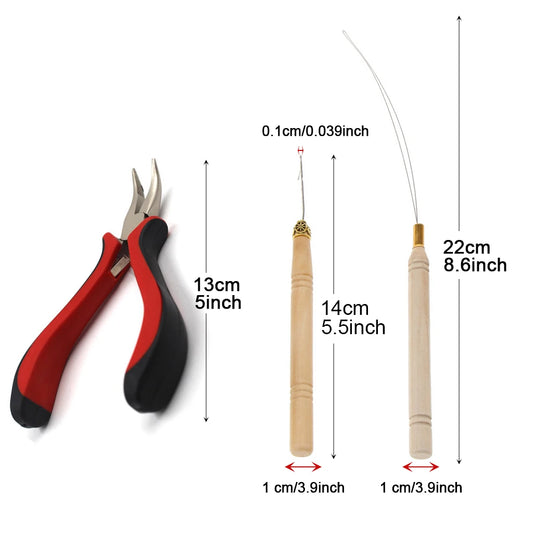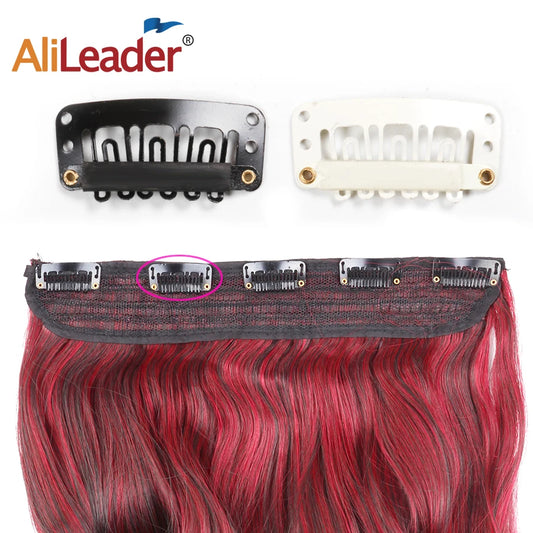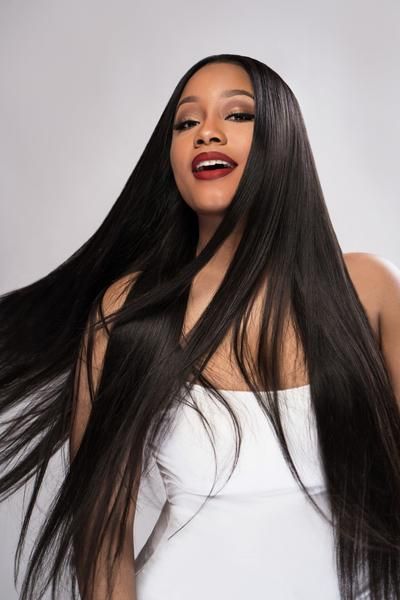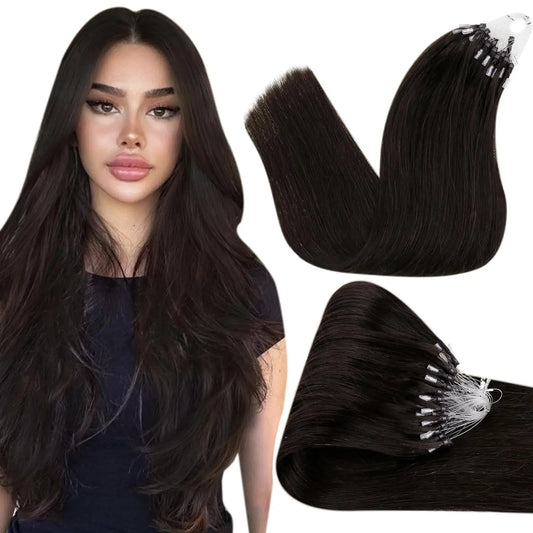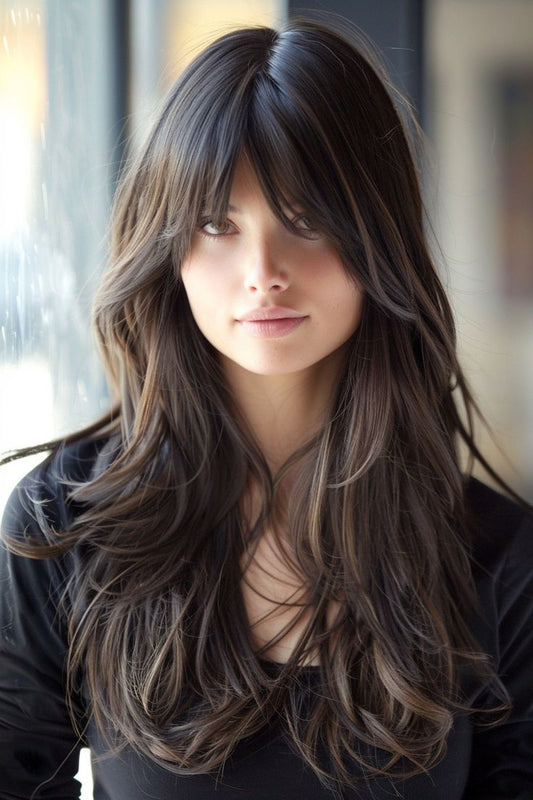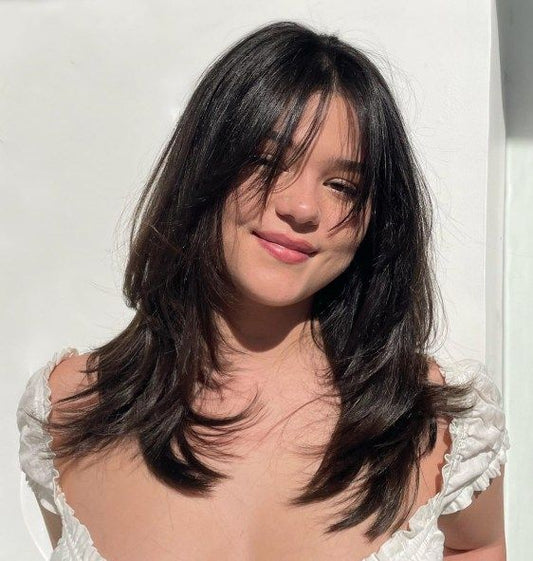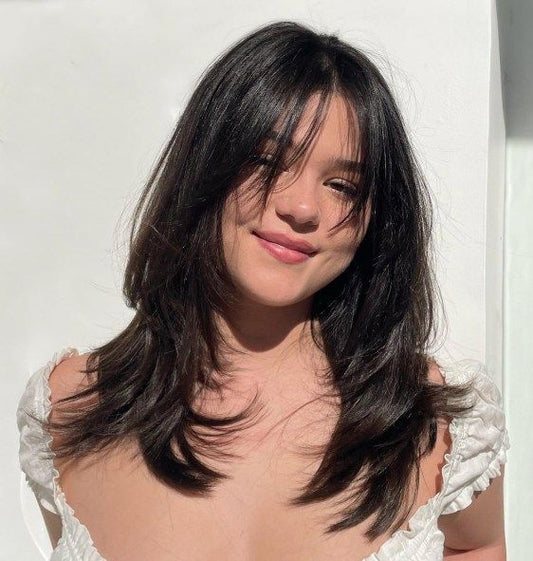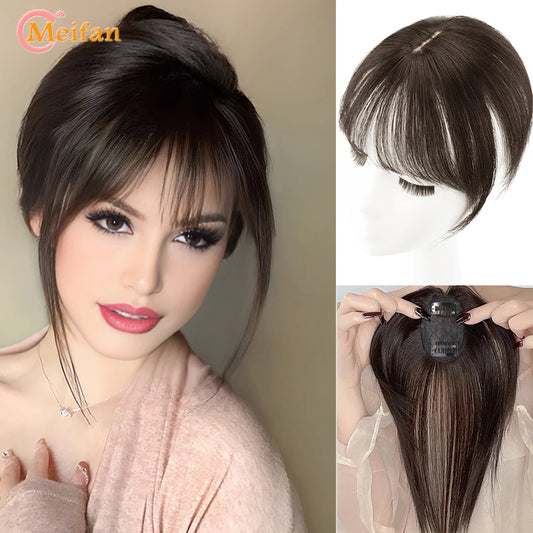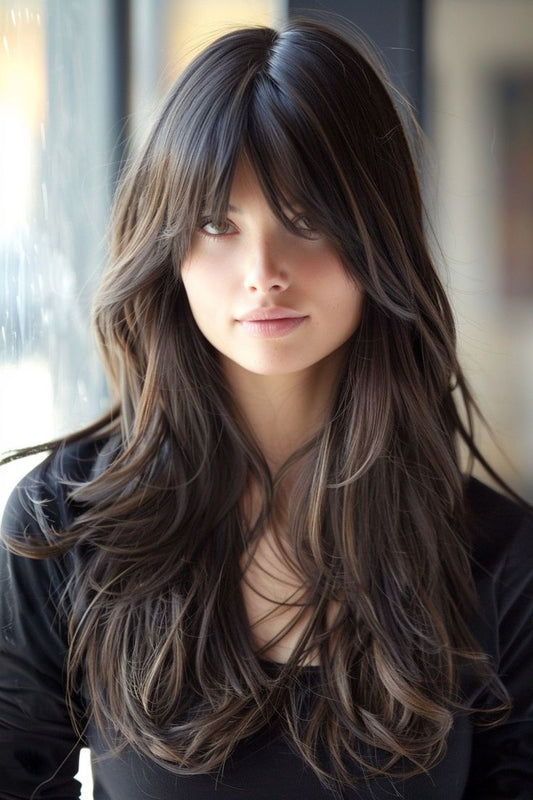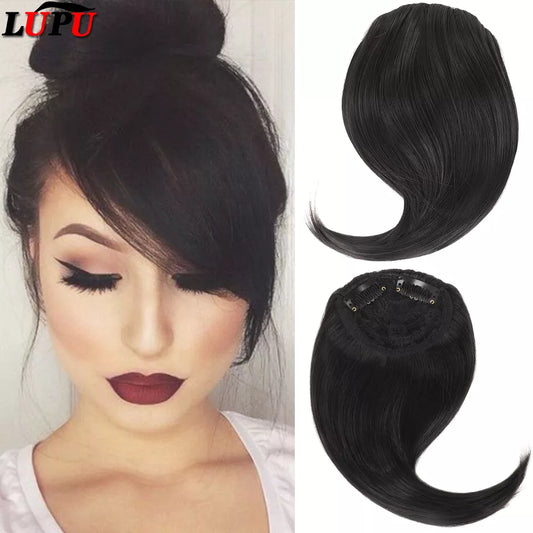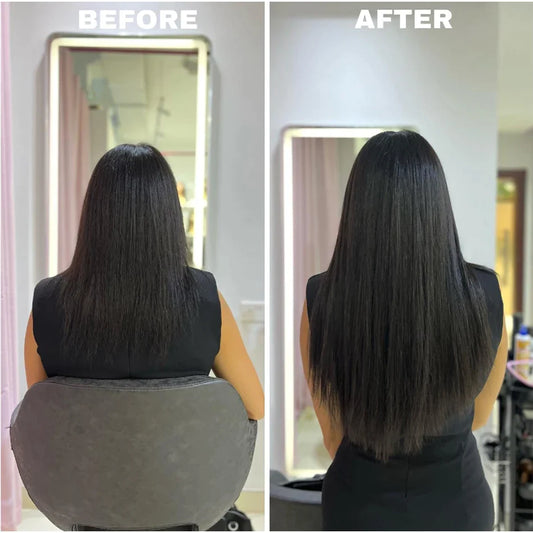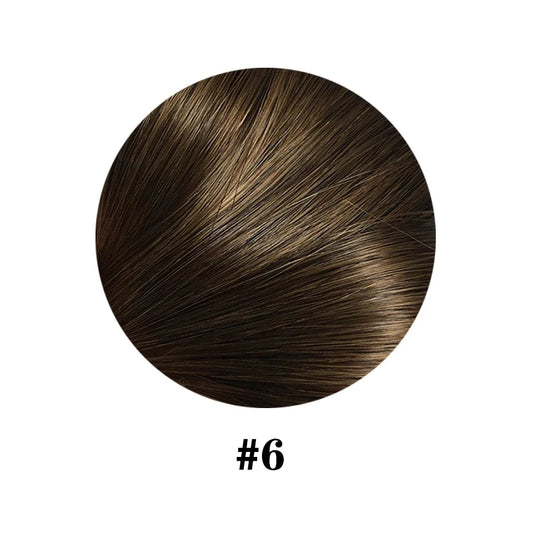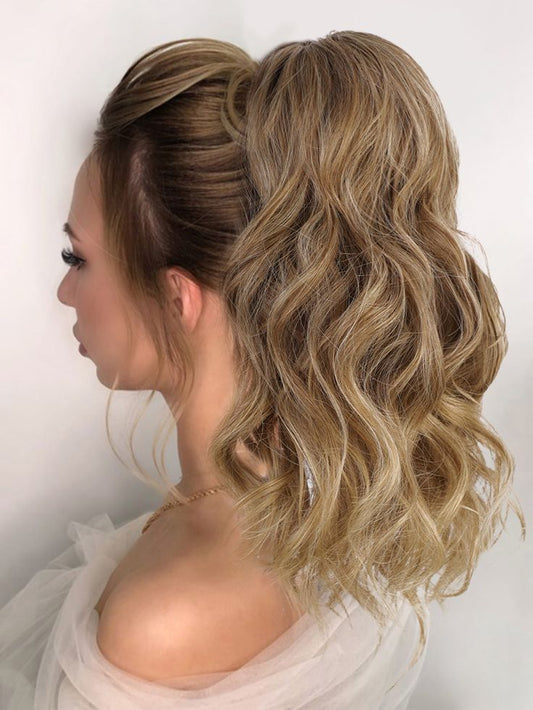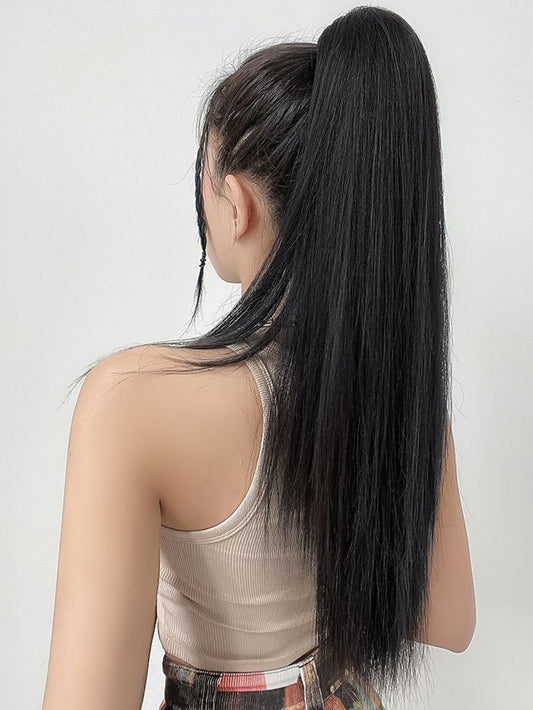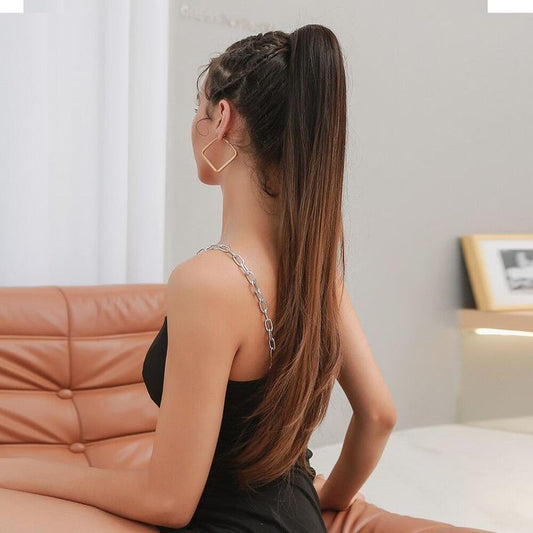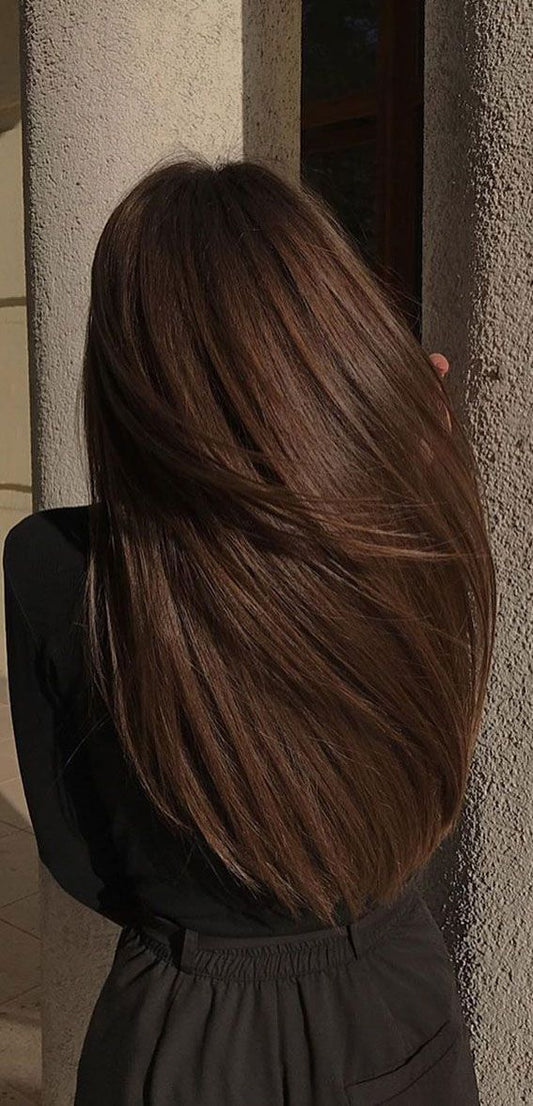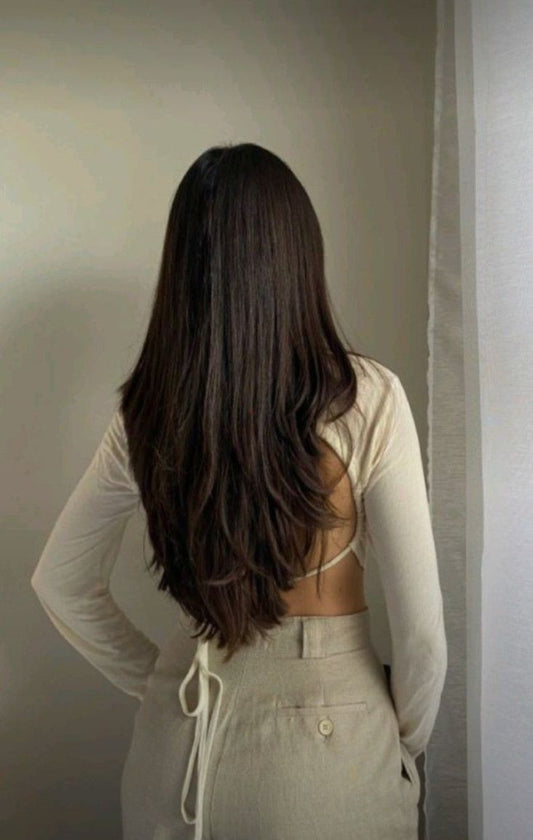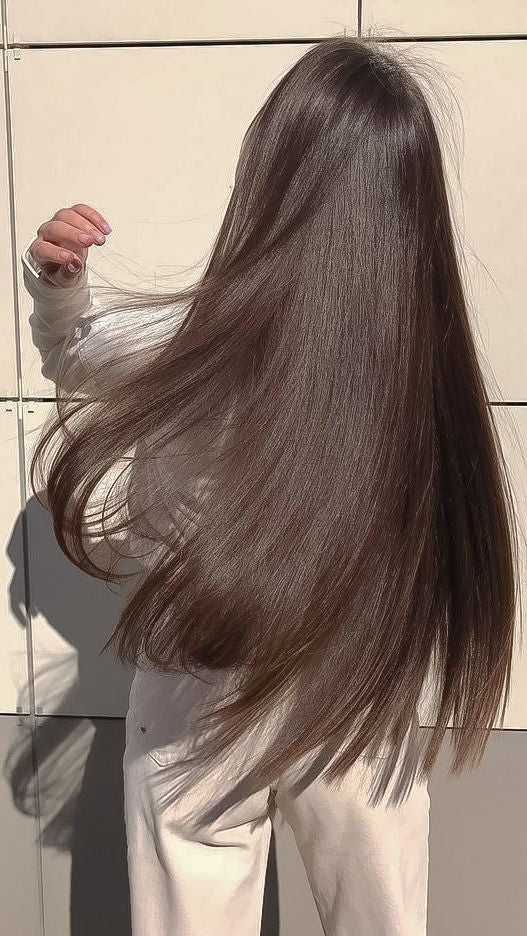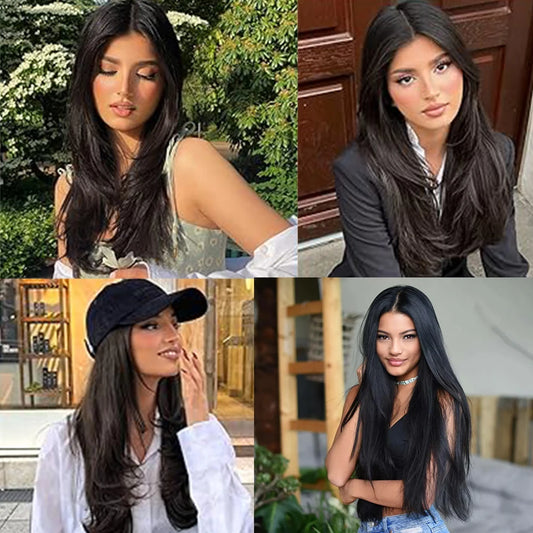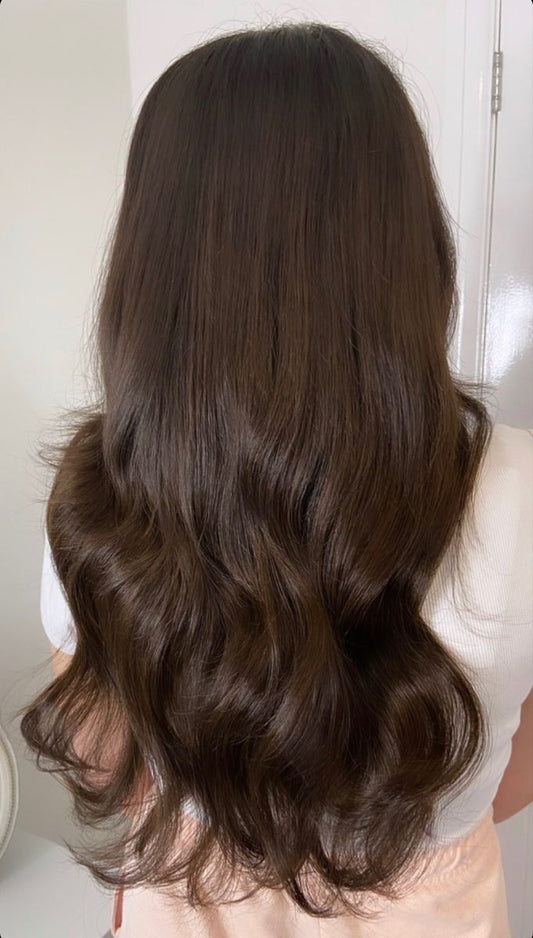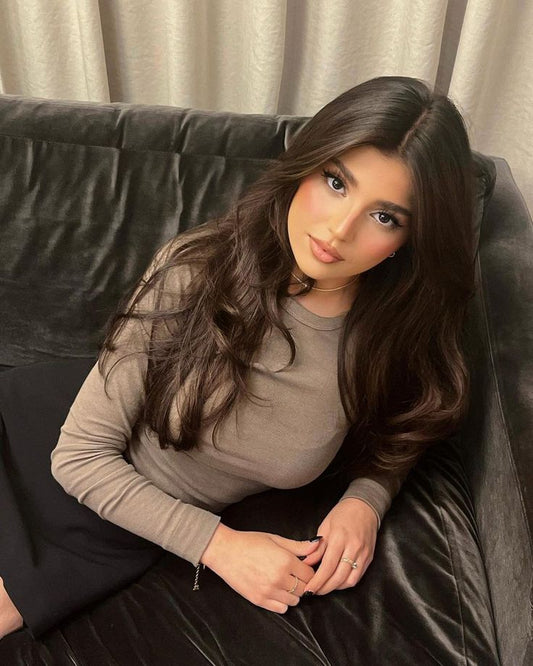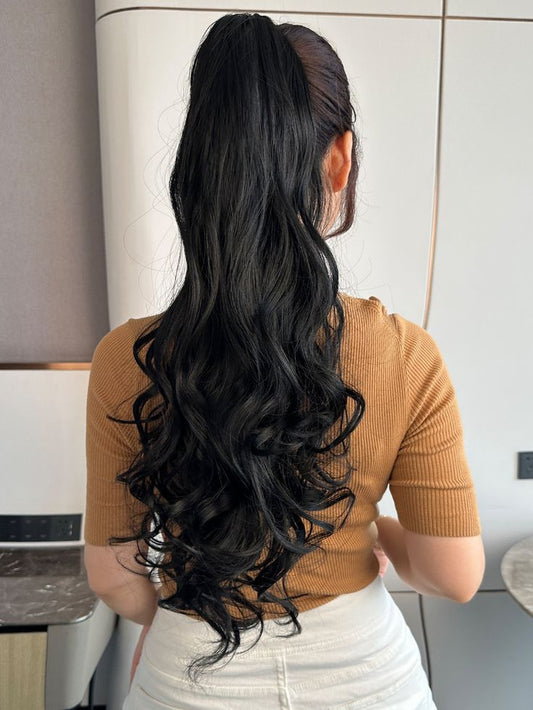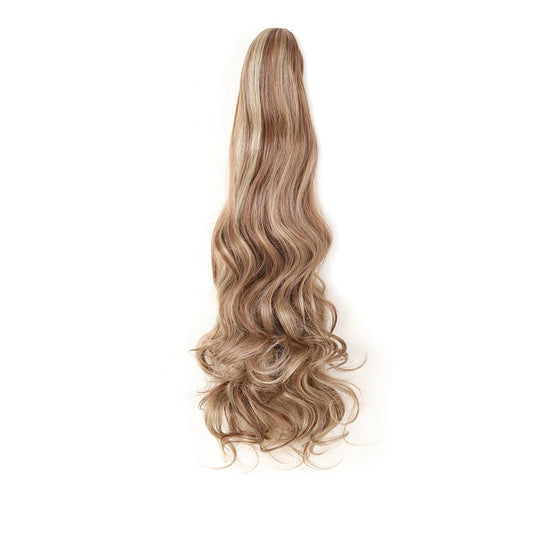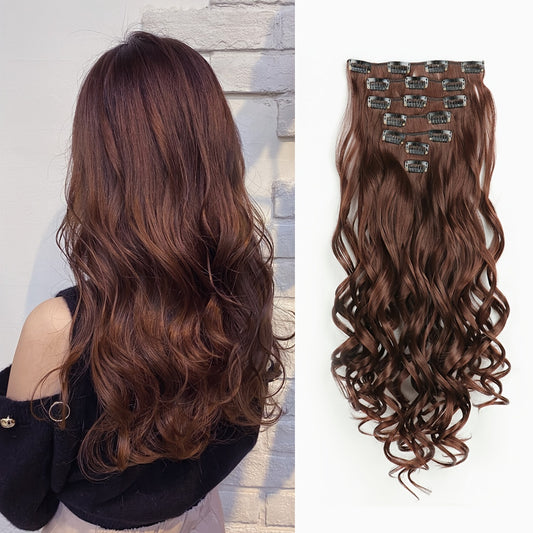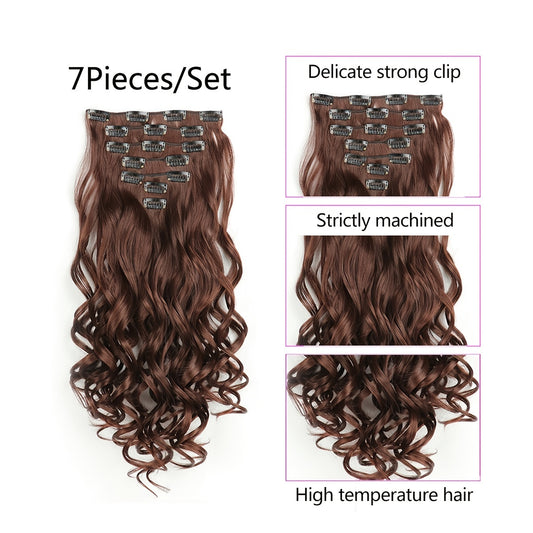About Dark Brown Hair Extensions
Shade overview
Dark brown sits one step above the deepest black values and holds more visible undertone. It can lean neutral, cool espresso, warm chocolate, chestnut, or mahogany. Because the tone contains red and gold micro cues in some lights, small engineering choices influence realism on camera and in person.
Who this serves
People who want depth, softness, and a natural read across offices, outdoors, and evening spaces benefit most. Dark brown blends seamlessly with many brunette roots, supports low-effort makeup, and pairs with earth tones, denim, navy, and cream.
Formats at a glance
Clip in sets give flexible density and quick changes at home. Tape in panels lie flatter, spread weight, and follow a salon schedule. Wefts support sew in and beaded row methods for structured silhouettes. Seamless clip ins hide the top edge under fine hair. One piece volumizers boost the crown when time is tight.
Fiber quality and realism
Aligned cuticles in human hair reduce scatter and preserve color integrity under mixed lights. High grade strands tolerate low to medium heat, respond to micro trims, and hold pattern after a full cool. Synthetic blends can shift toward plastic shine in warm LEDs or look dull in daylight; human hair tracks closer to natural optics.
Undertone logic
Neutral reads steady in most rooms. Cool espresso carries a soft ash that stays crisp near white walls and stainless fixtures. Warm chocolate shows gentle gold in warm lamps and sunlight. Chestnut holds red micro cues that appear in restaurants and at sunset. Mahogany tilts ruby under tungsten; choose this only if your wardrobe leans rich and warm.
Fabulive lists dark brown extension lengths, grams, and formats in simple numbers so planning is fast.
Finish target
Aim for satin with dimension. A measured sheen looks healthy while allowing low contrast shadow detail inside the wave. Heavy gloss looks artificial and ultra matte reads dusty. One slow pass at low heat, a full cool with zero touching, and one light brush merge strands into a calm sheet.
Length by picture
Decide by landmarks, not only inches. On many frames, fourteen touches the collar, sixteen meets upper shoulder, eighteen lands mid shoulder, twenty crosses upper back, twenty two rests mid back, twenty four reaches lower back, and twenty six signals runway long. Curves shorten the visual; straight reads longest.
Density planning
Weight acts like leverage at the neck. Light daily wear often feels calm around ninety to one hundred twenty grams. Everyday fullness commonly sits between one hundred twenty and one hundred fifty grams. Event builds can rise to one hundred sixty to two hundred grams if the base feels stable and comfortable.
Texture options and behavior
Straight reads sleek and modern, showing the richest espresso effect in daylight; it requires clean ends and a small bevel. Body wave hides micro joins and matches casual wardrobes. Loose curls add volume without heavy grams and soften jawlines. Coily textures look authentic when coil size mirrors your pattern and rows protect edge health.
Seams, joins, and coverage
Dark brown is forgiving compared to jet black but still exposes gaps. Stagger clip widths so their tops do not stack. Space tape panels evenly and avoid clear tabs that flash. For wefts, set consistent tension and neat fold backs so rows lie flat. Quiet seams beat product-heavy fixes.
Format selection
Fabulive’s shade tiles show daylight undertone from front and side, which speeds choosing between espresso, chocolate, or chestnut.
Choose clips for flexibility and quick removal. Choose tapes for flat panels and predictable salon cycles. Choose wefts if you prefer row control and a stylist’s shaping. Any format reads natural when crown density and hem density agree.
Hem line integrity
Ends that are too thin reduce realism in straight styles. Order slightly longer and schedule a micro trim so the line closes. In waves and curls, a softer hem is acceptable because motion hides the last few millimeters.
Mount height options
High mounts read energetic and open the neckline. Low mounts read sleek and protect edges. Mid mounts balance comfort and visibility. Higher positions increase pull; lower positions can rub collars. Pick one height for the day and keep it steady.
Base preparation
Seat hardware on clean, fully dry roots. Brush in the direction you will wear the hair. Keep oils away from attachment zones. For clips, create anchors. For tapes, clear residues. For wefts, braid uniformly or set beads evenly. Solid bases reduce adjustments in public.
Mechanical checks
After install, do a slow head turn to feel for slip, make a small jump to check tug, and run a jacket on off cycle to see if seams shift. Fix mechanics first; finish comes after mechanics are right.
Heat and set discipline
Use low to medium heat. Shape with one slow pass, cool fully, then brush once. Avoid clamping heat across seams. For curls, clip to cool so a lower temperature keeps pattern. Dark brown records heat marks less than black but still benefits from patience.
When inches must match outcomes, Fabulive provides clear length ladders and close hem shots so edge clarity is predictable.
Wash and dry routine
Wash when hair feels coated, not on a calendar. Use cool water and a gentle shampoo. Keep bond areas dry if your format requires. Condition mid lengths to ends, rinse until clear, blot, and air dry on a hanger so the perimeter stays true.
Storage and rotation
Store clean, dry hair in a soft, breathable pouch away from heat and sun. Label length, grams, texture, undertone, and last trim date. Rotate daily and event builds to spread wear and extend life.
Travel routine
Choose compact patterns that pack neatly. Keep a small brush and two pins in a pouch. On long rides, coil hair forward to limit seat back friction. In hotels, set up near a window with a pale surface opposite for consistent color checks.
Wardrobe mapping
Dark brown loves denim, navy, cream, and soft grey. Olive, camel, and tan make the tone warmer; a white tee near the face restores separation when outfits skew warm. Silver and gold jewelry both work; match metal to undertone—silver with cool espresso, gold with chestnut or chocolate.
Makeup pairing
Tidy brows, neutral contour, and brown or plum liners pair well. Day looks carry soft rose or peach lips; evening looks carry berry or brick. Avoid heavy orange bronzer at the hairline in cool rooms; it warms the frame on camera.
Lighting control
For care basics, Fabulive posts a concise wash routine and a do not soak the base reminder that fits real home use.
Designate one corner for prep and photos. Daylight by a window gives honest color. Office LEDs vary; restaurants skew warm. Clean the lens, lock white balance if possible, and take a profile still before posting. Brown shows undertone shifts quickly when light changes.
Creator workflow
Fix mount height, light angle, and lens distance for repeat shoots. Mark a floor point and save one reference image with exposure. Dark brown holds detail when inputs are constant.
Workday pattern
Set mid height, pick straight with a micro bevel or body wave, and keep grams moderate. Avoid oils at the base. Carry a tiny brush and two pins. A short routine done the same way daily keeps the look stable.
Event pattern
Choose mid or high based on neckline. Increase grams if comfort remains. Polish with one slow pass and a complete cool. Run the jacket test before leaving and capture a quick profile still under venue lights.
Edges and scalp comfort
Rotate mount heights across the week and keep tension firm but not tight. If edges feel stressed, lower grams or choose a lower mount for several days. A calm edge improves the whole read.
Trim strategy
Book a micro trim after install to join ends to your cut and remove factory bluntness. For layers, mirror your template so movement lines meet. Tiny changes at the hem transform photos.
If you want rooted options or texture specifics in dark brown, Fabulive’s product pages place root depth beside mid and end tones to make the join easy to picture.
Quality checks on arrival
Confirm length, grams, and texture against the order. Inspect seams for even stitching. Brush gently to shed loose cut ends. Photograph base and hem in daylight for records. If warm LEDs shift tone too red, verify undertone outdoors before deciding on returns.
System over mood
Pick fixed inputs—height, grams, length, texture, undertone—and reuse them. Small, steady inputs make the shade look deliberate across busy weeks.
Care economics
Extensions reduce dye cycles on your own hair. Lower heat and gentle rinse routines extend life. Rotating lighter daily sets with heavier event sets spreads wear and delays replacement.
Seasonal behavior
Winter air raises static, especially with wool. Mist water lightly before brushing. Summer humidity softens straight lines; body wave holds shape. In rainy weather, carry a soft pouch to coil hair forward between buildings.
Face shape mapping
Round faces benefit from body wave and slightly longer length. Oval faces accept most patterns. Square faces soften with loose curls or longer bevels. Heart faces balance with mid height and a line that passes the collarbone cleanly.
Stylist collaboration
Bring room photos, wardrobe notes, and a short list of target inches. Agree on gram targets, undertone, and a trim plan. Shared engineering choices produce reliable results.
Undertone tests in real rooms
Run three quick checks: daylight near a window, cool LED office, and warm lamp at home. If the tone shifts too red under warm light, pick neutral espresso; if it looks grey under cool strips, pick chocolate or chestnut. Choose for the room where you work most, not just the store light.
Photo exposure basics
Phone cameras lift exposure for faces and can wash brown undertone if white balance drifts. Lock exposure with a pale object in frame and step slightly off axis to your light. This keeps strand detail intact without filters.
Room and gear checklist
Headphones can nudge seams when clamp force is high; choose mid height that clears ear cups. Lanyards rub rows; route hair to the opposite side. Lavalier microphones near collars need a clean path so hair does not brush the capsule.
Row spacing and geometry
Spacing interacts with head shape. Wider spacing increases swing but needs more density per row. Narrow spacing distributes movement and can feel lighter. Keep the lowest row above collar contact to reduce jacket friction.
Hydration and slip control
Hydration keeps panels flexible; oils near attachment points cause slip. Add leave in to mid to ends only, keep bases dry, and mist water lightly in dry air to control static without changing sheen.
Commuter method
For bikes, choose mid height and compact wave to resist lift. On trains, coil hair forward against coats and release before exiting. In ride shares, sit slightly forward to keep seat belt contact off the hemline.
Wardrobe contrast matrix
Optical white gives maximum edge clarity. Bone, cream, and camel soften contrast and warm the read. Cool grey echoes espresso undertone and looks precise in offices. Navy strikes balance for most day looks.
Long term storage
Detangle dry, braid loosely, cushion with acid free tissue, and store flat in a breathable pouch. Avoid vacuum sealing which can crease seams. Label pouches with length, grams, texture, undertone, and last trim date for quick redeployments.
Optical separation from background
When hair and backdrop are both dark, step forward by half a meter and turn slightly from square. The move draws a light rim that outlines shape without sprays or heavy edits.
Chair and collar choreography
Blazers, hoodies, and high backed chairs press on similar zones. Before long sits, sweep hair forward over one shoulder, then return it after you stand. For hoodies, keep the hem above the collar line to prevent fleece scuffing.
Smartphone setup
Disable auto enhancements, clean the lens, and lock white balance. Clean optics and steady settings preserve brown texture that software smoothing would flatten.
Silhouette planning
Balance hair with clothing: straighter hems complement structured jackets; waves fit draped outfits. Treat silhouette as a single design so the head and outfit read as one idea.
Row curvature
Occipital depth varies. If the back of your head is flatter, curve rows a bit tighter so pieces follow the skull and do not lift at the corners under movement.
Elevator and lobby checks
Mirrors in elevators reveal side seams quickly; lobbies add mixed light. Use these moments to confirm profiles. If you see a shelf, reseat the upper pieces next stop instead of adding product.
Static control
Synthetics and dry air lift flyaways. Mist water lightly before brushing and allow thirty seconds for the surface to settle before moving. Optics stay cleaner when the panel is quiet.
Color drift across day
Morning reads cooler, late afternoon warmer. If your feed spans both, standardize on one time or use a white balance lock so the tone does not appear to change across posts.
Glare fixes by angle
Raise the light and shift it slightly to the side rather than spraying mattifiers. Dark brown looks premium when the surface is controlled by optics rather than coatings.
Wind recovery
After wind, step indoors, detangle from ends to mid, re-press seams, and do one wide tooth pass. Skip heat; the pattern returns as humidity equalizes.
Badge and cable routing
Clip badges lower or on the opposite side so lanyards do not saw across seams when you turn. Route headset cables under clothing to reduce rub points.
Hat coordination
Low beanies compress seams; choose a looser knit and mid height. For caps, route bulk through the opening and keep hems above collars so pressure does not stack.
Optics first mindset
If something looks wrong, change room, angle, or distance before changing hair. In deep shades, most issues are lighting problems, not hair problems.
Note card method
Write mount height, grams, length, texture, and undertone on a small card kept with the set. Update only when a change proves better three days in a row. This keeps results consistent when schedules tighten.
New set onboarding
When a set arrives, take a daylight still of ends and base, then a mixed-light still in your primary room. Keep both as references for future checks and reorders.
Install ergonomics
Sit with forearms supported to avoid over tightening at the crown. Lower strain yields better placement because you can work precisely for longer.
Natural hair crossover
Let extensions carry heat so your own hair rests. Track breakage and growth monthly. If roots improve, keep the routine; if not, lower heat further or reduce wear on off days.
Travel kit
Pack a soft pouch, small brush, two pins, a gentle cleanser decant, and your settings card. These reset optics anywhere without changing the style.
Storage rotation
If an event set sits for months, detangle, braid loosely, add tissue, and store flat. Label storage date and a target recheck month so you return to the right settings.
Phone model variance
Different phones render brown differently, especially reds. Test on your device and a friend’s. If tones drift, publish from one phone for consistency.
Crosswind handling
In open areas, sweep hair to the upwind side so it settles along the body rather than across the face. A single hidden pin under the wrap prevents base rotation.
Keyboard posture
If chair backs hit mid back often, bring hair forward during long typing periods. Preventing scuffing is faster than rebuilding dull patches later.
Neckline pairing
Mock necks and high collars pair with mid or low mounts so fabric and base do not compete along the nape. V-necks and scoop necks welcome mid or high mounts that open the line.
Video motion notes
Use a higher frame rate for smooth motion and stand slightly off axis to the key light so reflections travel rather than flatten. Browns with wave patterns read best this way.
Meeting to dinner switch
Set mid height and body wave for the day. Before evening, verify the hem, brush once after full cool, and capture a quick profile still. The base stays the same while polish increases.
Lens cleanliness
Wipe the lens before every photo. Fingerprints flatten detail and dull brown’s dimensional read. Clean optics protect good work.
Collar science
Sharp point collars can catch hems; rounded collars glide under length. Match collar shapes to mount height to avoid friction.
Skip list
Skip oils at roots, skip stacking sprays to hide mechanics, and skip last minute heat passes on already set panels. Skipping keeps surfaces clean and durable.
Undertone calibration recap
Fix five inputs—mount height, grams, length, texture, undertone—and choose one steady room for checks. Capture a daylight still and a warm lamp still on day one, then reuse exposure and distance. If color drifts, change the room or angle first; dark brown stays believable when optics stay constant.
Once a week, compare new photos to a daylight reference. If undertone or sheen drift, identify whether room, angle, or distance changed and reset that single input.
Consistency audit
Lens hygiene
Wipe the lens before every photo. Fingerprints mute mid-tone detail in brown, which people read as lower hair quality even when the hair is fine.
Coat and collar plan
High collars and structured coats push on the nape. Keep the lowest row above collar contact and verify with a jacket on off test before leaving.
Camera distance discipline
Arm’s length preserves outline. If you must shoot closer, angle slightly off-axis to your key light so reflections move without flattening tone.
Transit protection
On trains and rideshares, sweep hair forward and leave a small gap from the seat back. Returning the panel after the ride protects the finish.
Comfort as signal
A comfortable base disappears from awareness. Discomfort points to excess grams, mount too high, or uneven tension; correct one variable at a time and retest.
Profile still habit
Take one profile still before leaving. If seams read, adjust placement or mount height. Fixing mechanics first prevents over-styling later.
Hem geometry guide
A straight line reads graphic, a shallow U adds center length, and a soft V elongates the outline. Choose one geometry for a season to build visual consistency.
Color stability notes
Daylight leans cooler and lamps lean warm. Lock white balance once and reuse the same exposure distance so undertone does not drift on your grid.
Edge clarity checks
Film a slow side-to-side turn after install. If the top line prints under office LEDs, change clip angles or widen spacing rather than adding product.
Room repeatability map
Name one corner for prep and reuse it daily. Neutral wall, window light, and a simple bounce opposite stabilize tone so dark brown reads the same across devices.
Profile priority
Side views reveal more than front views. If profiles read clean, most other angles will follow.
Event scaling
For larger venues, raise grams only if comfort remains and polish the hem carefully. Big lights magnify edges and small errors.
Grid rhythm
Assign looks to days so the feed has pattern and you can compare like to like over time. Consistency also helps followers understand your style.
Device consistency
Post from one device when possible. Phone models render reds differently and can change how chocolate or chestnut reads across a grid.
Coat rehearsal
Put on the day’s coat and run a quick still at home. Adjust mount height now if the collar interferes.
Quiet workflow
Set, cool fully, brush once, and move on. Fewer touches keep the panel calm and believable under mixed lights.
Angle of brush
Brush in the flow direction. Cross-angle strokes create marks that scatter light and dull the finish in photos.
Parting micro shifts
Shift the part slightly to keep seams below sight lines and to refresh lift without heat.
Density matching
Let hem density echo your crown. Too much end weight on a fine crown reads wiggy; too little looks unfinished on a dense crown.
Common fixes
Crown gaps: add a narrow piece or shift part. Thin straight hems: trim millimeters or add grams. Over-shine: raise and angle light; under-shine: add soft side light.
Risk response
If a seam lifts, stop and fix. If tone skews, move the light or your position. Optics-first changes set the finish faster than products.
Sustainability habits
Lower heat, air dry, gentle cleansers, and rotation spread wear and reduce replacements. Planning grams wisely prevents overbuilding.
Maintenance rhythm
Micro trims keep hems graphic; early hardware fixes stay invisible. Schedule small maintenance instead of rare major overhauls.
Labeling shorthand
H=height, G=grams, L=length, T=texture, U=undertone. Example: H-M G-130 L-20 T-BW U-N. Short codes speed decisions and stylist notes.
Root realism
If your roots are slightly lighter, place one wrap strand half a step deeper than the tail. The shadow sells the join without products.
Hat compatibility
Use mid mounts and looser knits for beanies. For caps, thread bulk through the opening and keep hems above collars to avoid stacked pressure.
Glasses and earbuds
Test placement while wearing frames or earbuds. Clear temple paths avoid ongoing friction at the sides.
Recovery after humidity
When humidity softens straight lines, choose body wave and let sections cool longer. The pattern relaxes into clean movement rather than collapsing.
Timeline planning
Install, cool, brush, still, wardrobe, transit. Sequencing time prevents last-minute shine bands from rushed heat passes.
Exposure guardrails
Lock exposure with a pale object in frame and step off-axis to tame glare. This keeps brown’s detail intact without artificial filters.
Reel continuity
Note sweep direction and part placement between takes. Restart each cut with the same orientation so motion looks continuous.
Audio gear routing
Route headset cables under clothing and keep hair to the opposite side. Hair rubbing lav mics creates harsh noise that viewers misread as poor quality.
Fabric friction control
Smooth straps and linings preserve surface quality. Swap rough wool scarves for softer knits when wearing longer lengths.
Makeup nuance
Cool espresso loves taupe brows and plum liners; chocolate welcomes soft gold lids and brown liners. Keep bronzer soft at the hairline.
Outcome mapping
Choose three default looks—sleek with bevel, body wave mid, loose curl light—and schedule them across the week. Decision maps reduce morning friction.
Reference cadence
Refresh reference stills monthly in your main room. Keep one daylight and one warm lamp frame to spot undertone drift quickly.
Minimal kit
Small brush, two pins, soft pouch, gentle cleanser decant, and a settings card. This micro kit solves most issues in minutes.
Transit weather plan
Carry a soft scrunchie for wind and light rain. Coil forward on platforms and release indoors; one wide tooth pass restores alignment.
Seat strategy
On long days, bring hair forward during deep-focus work so chair backs do not abrade the hem. Return it before photos or meetings.
Contrast planning
Cream, bone, and soft grey keep undertone visible without harsh edges. Navy offers balance for meetings and travel.
Texture selection
Straight pairs with tailored jackets; body wave supports casual layers; loose curls soften strong jawlines; coily textures look authentic when coil size reflects your own pattern.
Weft fold backs
Finish each row with neat fold backs that lie flat. Ironed fold backs can print under camera; finger-pressed, cool fold backs blend into the base.
Tape care notes
Keep adhesive away from oils, offset panels vertically, and avoid clear tabs near hairlines. Small offsets remove shelf lines under bright office lights.
Clip seating details
Angle teeth slightly downward, close with intent, and test rotation with a gentle head turn. If a piece pivots, reseat shallower and retest.
Mount height logic
High emphasizes neck and movement; mid balances comfort; low protects edges and collars. Choose based on outfit and day’s tasks, then keep it fixed.
Back view audit
Use a second mirror or timer photo to inspect the back. Look for scallops at the hem and shelves near the crown. Micro trims and spacing fixes tidy the outline.
Room naming
Name rooms in notes—window east, corridor LED, kitchen lamp—and tag photos. Clear naming lets you reproduce wins quickly.
Detangle discipline
Support sections, comb from ends upward, switch to a soft brush, and stop if you feel resistance. Forcing a pass adds micro frizz that lights will amplify.
Cooling patience
Heat sets only when fibers cool. Hold curls in clips until room temperature returns. A full cool keeps definition with less heat and less maintenance.
Density harmony
Match hem fullness to crown density so the head reads as one unit. If the crown is fine, lighter grams with wave look most believable.
Row architecture
Lower rows track the nape curve; upper rows widen slightly through the parietal area. A consistent arc prevents corner lift and reduces micro shadows on camera.
Seam invisibility checklist
Stagger tops, keep even tension, and leave a finger’s width near the hairline. If a line prints in profile, change angles before adding product.
White balance card usage
A simple white card or a pale doorframe sets color. Lock the setting and reuse it for the week. This control stops day-to-day undertone drift in feeds and reels.
Shadow shaping
Place your key light slightly above eye level and a step to the side so shadows carve gentle depth through the mid lengths. Subtle shadow preserves dimension in dark brown without forcing high gloss.
Customer reviews
- The espresso neutral undertone reads natural in my office and outside; one low heat pass and a full cool gave a calm surface that held through meetings and the commute. — Ava Mitchell, USA ⭐⭐⭐⭐⭐
- 18 inches landed at mid shoulder for me and blended after a tiny trim at the ends. — Oliver Hughes, United Kingdom ⭐⭐⭐⭐⭐
- Under warm restaurant lights I saw a soft chocolate glow instead of red flare; locking white balance made videos consistent. — Mia Thompson, Australia ⭐⭐⭐⭐⭐
- Conference week: mid height, body wave, moderate grams. Secure base and no profile flash even with badges and lanyards. — Noah Carter, Canada ⭐⭐⭐⭐⭐
- It moves well and the hem looks deliberate after a micro bevel; the tone stays steady next to navy and cream outfits. — Sofia Romano, Italy ⭐⭐⭐⭐⭐
- Quality is strong; shipping arrived a day late so four stars, but the blend at the crown is excellent and seams stay quiet. — Felix Bauer, Germany ⭐⭐⭐⭐
- On video calls the part line never flashed, and the color held true under cool LEDs; it feels like my own hair on camera. — Chloé Bernard, France ⭐⭐⭐⭐⭐
- Tried it on a windy harbor walk; the base never rotated and the jacket test saved me from surprises. — Liam de Vries, Netherlands ⭐⭐⭐⭐⭐
- First dark brown set for me; the small card with height, grams, inches, and pattern turned mornings into a two minute routine. — Aria Sato, Japan ⭐⭐⭐⭐⭐
- Great hair overall; I would only adjust the pickup window. The chestnut undertone looks rich in daylight after a single rinse. — Daniel Meier, Switzerland ⭐⭐⭐⭐

